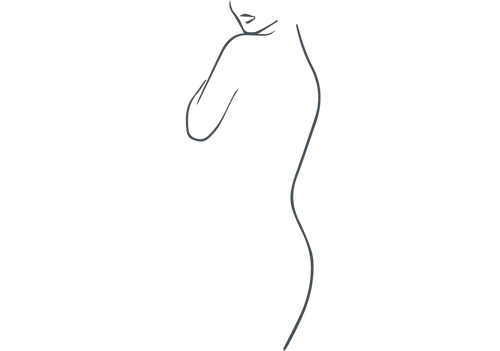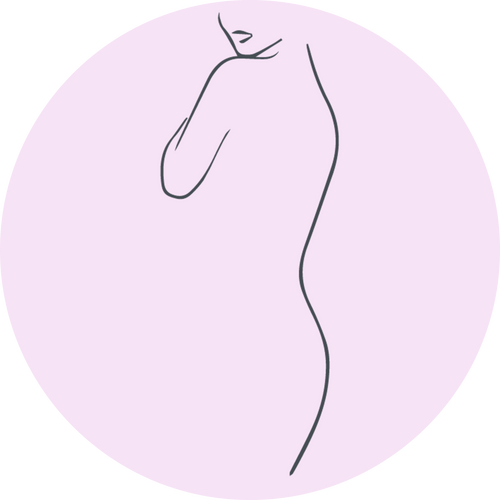The bra, a foundational garment in women's fashion, serves both functional and aesthetic purposes. Understanding its anatomy is essential for selecting the right fit and style, as well as for those interested in sewing their own bras. A typical bra consists of several key components, each contributing to its overall structure and effectiveness.
So let's take a look at what a standard bra consists of, taking a T-shaped cup bra as an example and bearing in mind that there are still many other designs out there.

FABRIC DETAILS
1. Upper Cup
The upper cup of a bra plays a crucial role in both the aesthetic and functional aspects of the undergarment. It is the portion of a bra with pieced cups (seamless bras do not have such division) that covers the upper part of the breast, contributing significantly to the overall shape and support provided by the bra. The design and construction of the upper cup can vary widely, influencing fit, comfort, and style.
2. Lower Inner Cup & 3. Lower Outer Cup
The lower inner cup and the lower outer cup of a bra are primarily responsible for providing support to the breast tissue. These pieces are typically designed to cradle the breast, ensuring that it is held securely in place. Therefore lower cup details are often slightly padded (extra padded for push-up effect) or stabilized with lining fabric. The construction of the lower cups can also vary significantly depending on the style of the bra.
4. Bridge
The bra bridge, also known as the center gore, is a critical component in the construction of bras. This section of the bra connects the two cups and it is located at the center of the garment, directly over the sternum. The bridge has to be well-constructed and lined with stabilizing fabric because it helps to maintain the shape of the bra and ensures that the cups remain in the correct position on the body. The design and construction of the bra bridge can greatly influence the overall fit and support provided by the bra.
5. Side Band
The side band is the part of the bra that extends from the front of the bra to the back, providing essential support and shaping to the bust.
As well as the bridge, it has to be well-constructed and preferably lined with stabilizing fabric because it helps to maintain the shape of the bra and ensures that the cups remain in the correct position on the body.
6. Back Band
The back band is the horizontal band that runs across the back, anchoring the bra to the body. Typically (depending on construction) made from elastic fabrics, as the elasticity of the band allows for a snug fit, which is vital for maintaining the bra's position and providing comfort throughout the day.
FINISHING DETAILS - NOTIONS
7. Underwire & Channeling
The underwire, typically made from metal or plastic, is sewn into the special channeling (underwire casing) or fabric of the bra and serves couple purposes that enhance both support and lift the bust for more aesthetic look, helping to create a defined shape.
8. Side Bone & Channeling
Side boning, on the other hand, refers to the additional support structures placed along the sides of the bra. These are usually made from flexible materials such as plastic that allow for some movement while still maintaining the bra's shape.
The inclusion of side boning serves multiple purposes: it helps to anchor the bra in place, prevents side spillage, and contributes to a smoother appearance under clothing.
Just as underwires, side bones are sewn into the special channeling (underwire casing) or fabric of the bra.
9. Under Band
It is the part of the bra that wraps around the ribcage, sitting just below the bust. The under band is responsible for anchoring the bra in place, ensuring that it does not shift or ride up during wear. This stability is essential for maintaining the overall fit and function of the bra.
When considering the design of the under band, various factors come into play, including the width, material, and elasticity. Wider under bands tend to distribute pressure more evenly across the ribcage, which can enhance comfort, especially for larger cup sizes. Additionally, materials that offer a blend of elasticity and firmness (such as elastics) are ideal, as they provide the necessary support while allowing for some movement.
10. Underarm
The underarm line is designed to stretch and conform to the body's natural movements, while ensuring that the bra remains securely in place.
In addition to support, the underarm line contributes to the overall aesthetic of the bra. Designers often incorporate various elastic band widths, colors, and textures to complement the bra's style and enhance its visual appeal. For instance, a wider finishing elastic may be used in full-coverage bras to provide additional support, while a narrower elastic might be favored in more delicate designs.
11. ...
This detail may be considered as a continuation of the underarm elastic band. Sometimes the design itself includes a straight transition from the cups to the hook & eye closure.
12. Strap
Bra straps provide support to the bust and help maintain the bra's position on the body. The design, position and material of bra straps can significantly influence comfort, fit, and overall appearance.
There are several types of bra straps, each designed for specific styles and functions. The most common types include:
1. Standard Straps:
These are the most prevalent type of bra straps, typically adjustable and made from elastic materials. They provide basic support and can be found on most bra styles.
2. Racerback Straps:
Designed to prevent slipping, racerback straps converge at the back, creating a 'X' or 'Y' shape. This design is particularly useful for wearing under sleeveless or tank tops, as it minimizes visibility.
3. Strapless Straps:
These straps are designed for strapless bras and often feature silicone or rubber lining to prevent slipping. They provide support without the need for traditional straps, making them ideal for formal wear.
4. Convertible Straps:
These versatile straps can be adjusted to be worn in multiple ways, including standard, halter, or crisscross styles. This adaptability allows for greater flexibility in wardrobe choices.
5. Decorative Straps:
Some bras feature decorative straps that enhance the visual appeal of the lingerie. These can include lace, embellishments, or unique patterns that add a stylish touch.
13. Neckline
There are several common types of bra necklines, each designed to complement specific clothing styles. For instance, a plunge neckline is ideal for low-cut tops and dresses, providing a seamless look while enhancing the décolletage. Conversely, a high neckline offers more coverage and is suitable for high-necked garments, ensuring that the bra remains discreetly hidden.
Usually elastic band is added which fit snugly around the neckline, ensuring that the cup stays securely in place and does not stretch out over time.
14. Hook & Eye Closure
The hook & eye closure is the most prevalent type of buckle found in bras. It consists of hooks that clasps into eyes, allowing for adjustable sizing. Typically, bras feature multiple rows of hooks and eyes, enabling wearers to customize the fit according to their comfort level.
15. Ring
Bra rings are typically made from materials such as plastic or metal and serve as anchors for the straps. They allow for the adjustment of strap length, which is essential for achieving a personalized fit. The use of rings enables the wearer to modify the bra's support level, which can be particularly beneficial for individuals with varying body shapes and sizes.
16. Slider
Sliders, on the other hand, are the mechanisms that facilitate the movement of the straps through the rings. They are designed to hold the strap securely in place once the desired length is achieved. The effectiveness of sliders can significantly impact the overall comfort of the bra. A well-designed slider will allow for smooth adjustments without slipping or loosening during wear.


